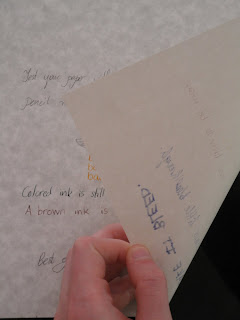Where to begin the new journal project? The cover materials and design will be vital to the final effect, but the structure of a book starts with its paper. In any book, that's what you spend most of your time looking at, at least as a background to the ink of its words; but with a journal, all there is at first is paper.
So, a good start means good paper, which means this time I can't just use normal printer paper. It's too plain and familiar, for one thing, but also too bright white, too flimsy, and just not at all suitable for a proper tome. So, I want paper that's at least off-white and of a decent weight, if not even luxurious. It also has to come in a large size. Most importantly, since this is a tome and I know its owner will do right by it, I fully expect ink and quill to be in regular usage, so it has to accept India ink without bleeding or spreading in weird ways. I found a few candidates:
- Manila drawing paper, 40# 12" x 18". Plenty heavy and inkable, the sheet size would allow for 9" x 12" pages, very respectable. However, it's maybe a little too heavy and too far from white.
- Strathmore 400 series drawing paper, 80# 12" x 18". Same size as the previous, it's off-white and should take ink just fine, but it's a bit dear and holy cow does it only come in that cardstock weight?
- Southworth ivory parchment paper, 24# 11" x 17". This stuff looks nice. It's the right weight, it's off-white, and should be thick enough to prevent bleeding. I'm a little apprehensive about the variegated color, which could affect legibility, but hey, it'll look more like an actual old manuscript, which is great.
- Color copy paper, 28# 11" x 17". Just included as a last resort; it's bright white printer paper, so ew, but it comes in appropriately large ledger-size sheets and has a respectable, not-too-heavy weight. Also it's cheap and so would allow for a very high page count.
In the end, I ordered the parchment paper. This was a good choice. Here's my test page, once I got it in person, being subjected to every writing utensil I could think to use -- ball-point pen, pencil, calligraphy ink in various colors, and finally Sharpie:
The calligraphy ink was completely invisible on the reverse, and it took a thick Sharpie to produce even mild bleedthrough. The pencil lines weren't even as hard to read as I'd feared. Pretty much any journal I've ever written in can go suck it.
So, I proceeded to fold twelve signatures of four sheets each, making for a book of 96 leaves or 192 pages. Final dimensions of each page: 8.5" x 11". That's larger than all but the big art books on my shelves, so I think my scale condition is satisfied -- and with what style! I'm having an affair with this paper.
Don't give me that look, I'll NEVER apologize for love.
TO BE CONTINUED! Next up, I'll show you the stitching and gluing of the spine, maybe more if I get a lot achieved.




Tip on paper - have you tried using "parent sheets" (big, like 26x38 in.)? I found that I can order them through a paper store (Xpedex) and not pay shipping. I even discovered if I order just 5 sheets, they typically throw in about 10-15 sheets for free! I can get the big sheets for anywhere from $0.69- 0.89, and I typically only need 4 sheets for a textblock. You should try it!
ReplyDeleteI figured something like that must exist, but couldn't find any suppliers (well, apart from this place: http://handmade-paper.us). If I go into major production mode, that will become enormously useful. Thanks again for the tip!
Delete